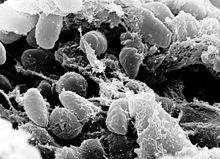New technology used to map Yersinia pestis: New era of research into infectious diseases?
How cool would it be to track your ancestors back over 650 years? Well, if you are a Yersinia pestis, you are lucky because recently a group of Canadian scientists mapped the entire genetic makeup that will allow researchers to track your ancestor’s evolution and virulence over the centuries.

A scanning electron microscope micrograph depicting a mass of Yersinia pestis bacteria. Source: Wikipedia
So you may ask, what is a Yersinia pestis? Yersinia pestis is the bacteria that caused the Black Death in Europe. The epidemic caused by the bacteria was so great that it is estimated to have killed 30-60% of the population of Europe, in a span of two years. Due to their high virulence, when left untreated with antibiotics, two-thirds of those that get infected die usually within four days.

Source: Wikipedia
Source: Vancouver Sun
To gather data on the bacterium, the scientists took the remains of bones and teeth samples, carefully went through each piece to get all the different DNA’s found on the body. Then they filtered through all the DNA’s to find the one that belonged to Yersinia pestis. This “fishing” method of DNA could be used to study and reconstruct other ancient pathogens that turned into deadly killers, according to one of the researchers.
The Canadian scientists found that while comparing their reconstructed plasmid against the modern Y. pestis, it was found that the varient of Y. pestis maybe no longer be existing today. However, their study shows that Y. pestis DNA was found in the medieval dental tissues from the victims of the Black Death. This is another support that strengths the hypothesis that this bacterium was the organism that caused the medieval plague.
So, the mapping of Y. pestis may just be the start of genetic mapping of bacterial species. I wonder which virulent bacterium will be mapped next, revealing its stories of mutations and evolution through time.
More Info:
Original Paper:
http://www.ncbi.nlm.nih.gov.ezproxy.library.ubc.ca/pmc/articles/PMC3179067/
Original News Article:
October 17th, 2011 at 11:15 am
What a combination of skills of archeology and life sciences used to map Yersinia pestis! It is quite interesting because of the interdisciplinary nature of the study. A question that I have is: why is it important to study the history or the evolution of bacteria?
October 17th, 2011 at 6:19 pm
Maybe it is so that we could observe a trend in the evolution and estimate how the bacteria would evolve in the future. In that case, we could start researching in the drugs instead of having numbers of people being infected by the new evolved bacteria first.
October 21st, 2011 at 9:29 pm
I also find the interdisciplinarity of this work fascinating. As for the importance of the study I’ll have to defer to someone else, but I suspect Steven is probably on the right track.